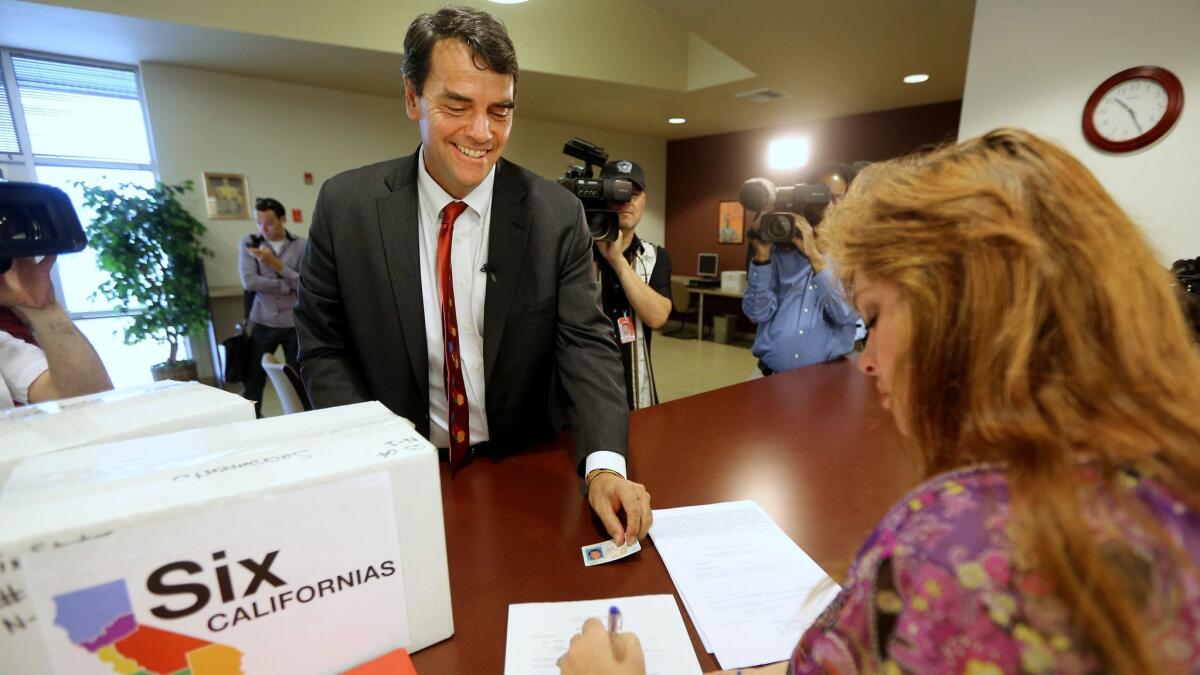Column: Gambling on a California split has its allure, but it’s too much hassle — and a ‘real threat’

Reporting from Sacramento — Troublemaker Tim Draper’s latest proposal to split California into three states has some appeal for Northerners. At least it does for me.
That doesn’t mean it’s a smart idea. It’s impractical, a fantasy and doomed. But it does have an allure.
In November, Californians will have an opportunity to vote on whether to split the state in thirds because the venture capitalist’s initiative qualified for the ballot last week. So this is no longer just an idea for idle chit-chat. It’s potentially achievable, if highly remote.
Look, here’s one attraction for a Sacramentan: The new “Northern California” would be the second-wealthiest state in the nation, ranking only below Connecticut in terms of per capita personal income. The Legislative Analyst’s Office pegged it at $63,000, based on 2015 data, the latest available. For the entire state it was $54,000.
That wealth is because of the San Francisco Bay Area, especially Silicon Valley.
What it means is there’d be fewer people unemployed and on public assistance than in the other two new states: Los Angeles-dominated “California” and weirdly drawn “Southern California.” There’d be less northern tax money spent on the safety net and more for universities, transportation, parks and other lifestyle goodies.
And “Northern California” would have some pretty nice places: the Golden Gate Bridge, big old redwoods, Napa-Sonoma wine country, Mount Shasta, Lake Tahoe and Yosemite Valley.
Also, it would have the California Delta — and more muscle to protect this recreational, fisheries and small-farm haven from southern water-grabbers.
The new “California” would include the unexcelled coastline from Santa Monica Pier up Highway 1 through Santa Barbara, San Simeon, Big Sur, Carmel and Monterey.
But it also would have the many thousands of L.A. homeless to deal with plus traffic congestion — and it would be tasked to find solutions without Bay Area tax dollars.
Draper’s “California” would comprise six counties: L.A., Ventura, Santa Barbara, San Luis Obispo, San Benito and Monterey.
“Southern California” seems odd. Ancient Mono Lake in the eastern Sierra would be in “Southern California.” So would Mount Whitney and Fresno.
There’d be 12 counties: San Diego, Orange, Imperial, Riverside, San Bernardino, Kern, Inyo, Mono, Kings, Tulare, Fresno and Madera.
The legislative analyst says the state “would have below average income levels compared to the rest of the country.” That means less tax revenue. But it would need to pay for the highest share of Medi-Cal and welfare recipients among the three states.
All the other 40 counties would be in “Northern California.”
The three states’ populations would be similar, ranging from 12 million to 14 million each.
Politically, the north and “California” would be reliably Democrat. The south would be competitive, but I suspect lean Republican.
By creating two new states, California would gain four U.S. Senate seats. So there’d be six senators total. Four would surely be Democrats. The other two seats would be up for grabs, but probably go Republican.
The four new Senate seats would mean there’d also be four additional presidential electoral votes on top of the current 55, the most in the country.
Coverage of California politics »
So that’s a big reason why this midsummer night’s dream — or nightmare — is doomed. Congress would need to approve it and so would the president. That’s not going to happen while Republicans control Congress and there’s a President Trump. And even if Democrats were to recapture Washington, it’s hard to see them tinkering with the sweet deal they now have in this blue state.
The proposal also oozes with potential problems.
Would an L.A. kid enrolling at UC Berkeley be forced to pay out-of-state tuition? What would become of the University of California?
How would responsibility for all the state’s current debts be divvied up — money owed on infrastructure bonds and unfunded liabilities for public employee retirements?
And this sure smacks of a bitter water war.
Think about it: L.A. imports about 90% of its water from sources that would be out of state. And many people where the water originates resent that. Current state contracts probably couldn’t be voided. But future add-ons, such as Gov. Jerry Brown’s monstrous delta tunnels? Forget it.
Draper dismisses such talk.
“Just set it up in [an interstate] compact,” he told me.
OK, but it took decades of costly court battles before California and Arizona ended their fight over the Colorado River.
Draper, a San Mateo County billionaire, has a history of political rabble-rousing. In 2000, he sponsored an initiative to provide taxpayer-funded $4,000 vouchers for kids attending private schools. Voters overwhelmingly rejected it.
Four years ago, he tried to split California into six states, but that didn’t make the ballot.
“That was too much of a mind-blower,” he conceded. “But this is catching on.”
“California has just gotten worse and worse,” he continued. “The idea is let’s create a clean slate, clear the deck, empower more people and get them closer to the government.”
Former state Assembly Speaker Fabian Núñez gives the best reason for voting “no.”
“We shouldn’t be wasting time with this,” he told me. “It’s such a dumb idea, but it’s a real threat. Let’s suppose he puts up $50 million and it passes. Even if Congress votes it down, it starts a conversation that’s unnecessary. We should be talking about the real issues of healthcare access, energy, homelessness.”
But if Draper ever wants to split the state in two at the Tehachapi Mountains….
On second thought, nix that too. It was a good idea once. Too much hassle today.
Follow @LATimesSkelton on Twitter
More to Read
Get the L.A. Times Politics newsletter
Deeply reported insights into legislation, politics and policy from Sacramento, Washington and beyond. In your inbox three times per week.
You may occasionally receive promotional content from the Los Angeles Times.











